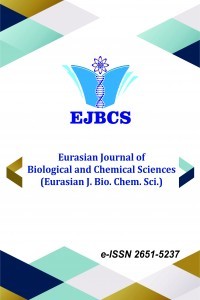CT Imaging, Macroanatomical and Morphometric Analysis of Os penis in Brown Bear (Ursus arctos)
CT Imaging, Macroanatomical and Morphometric Analysis of Os penis in Brown Bear (Ursus arctos)
The aim of this study is to reveal the macroscopic features of the brown bear (Ursus arctos) os penis (baculum), as well as its morphometric measurements with the help of computerized tomography and digital electronic caliper. The study material was obtained from an adult male brown bear weighing approximately 400 kg, which was brought to the Wildlife Protection and Rehabilitation Unit of Kafkas University and died as a result of a traffic accident in the Sarıkamış district of Kars. After the skin and soft tissues around the baculum were removed, they were kept in hydrogen peroxide for 2-3 hours. In the macroscopic examination, it was determined that the baculum was straight, close to the pen, except for a slight curve in the distal part, and ended with a small tubercle at the distal end. A small notch was found in the proximal part. In addition to the prominent sulcus urethralis in the ventral of the baculum, a short groove was also detected in its lateral. In addition to the prominent sulcus urethralis in the ventral of the baculum, a short groove was also detected in its lateral. A cartilage tissue of 11.08 mm in length and 4.67 mm in thickness was determined in the distal of the bone. In the morphometric measurements made with a digital electronic caliper, the length of the baculum was 148.95 mm, while the diameters were measured as 4.58 mm in the distal and 13.72 mm in the proximal, respectively. In computed tomography, baculum length was 148.84 mm, distal diameter length was 5.63 mm, and proximal diameter length was 13.12 mm. In addition, computed tomography measured the length of the cortex as 0.76 mm, the length of the medulla as 5.74 mm in the distal, and the cortex length of 0.77 mm and the medulla length of 5.32 mm in the proximal region. As a result, in this study, the macroanatomical and morphometric features of the brown bear baculum, which live in high altitude and cold climate conditions, were revealed.
Keywords:
Brown bear baculum, os penis, macroanatomy, morphometry, CT,
___
- 1. Servheen C, Herrero S, Peyton B, Pelletier K, Moll K, Moll J (1999): Bears: status survey and conservation action plan (Vol. 44) . IUCN.
- 2. McLellan BN, Servheen C, Huber D (2008): "Ursus arctos". IUCN Red List of Threatened Species. 1. International Union for Conservation of Nature. Retrieved 2013-10-05.
- 3. Zedrosser A, Dahle B, Swenson JE, Gerstl N (2001): Status and management of the brown bear in Europe. Ursus, 9-20.
- 4. Parker SP (1990): Grzimek's encyclopedia of mammals. McGraw-Hill, New York. ISBN 0-07-909508-9 (set).
- 5. Nowak RM (1999): Walker's mammals of the world (Vol. 1). JHU Press.
- 6. Dursun N (2000): Veteriner Anatomi. Medisan Yayınevi, Ankara.
- 7. Nickel R, Schummer A, Seiferle E (1981): The Anatamy of the Domestic Animals. Vol 3.First Edition. Verlag Paul Parey, Berlin.
- 8. Getty R (1975): The Anatamy of Domestic Animals. Fifth Edition. WB Saunders Company, Philadelphia.
- 9. Gültiken M, Yıldız D, Bolat D (2004): The anatomy of os penis in red fox (Vulpes volpes). Ankara Üniv Yet Fak Derg, 51, 71-73.
- 10. MiIler ME (1979): Miller's Anatomy of the Dog. WB Saunders Company, Philadelphia.
- 11. Miller, EH., KW Pitcher, TR Loughlin 2000. Bacular size, growth, and allometry in the largest extant otariid, the Steller sea lion (Eumetopias jubatus) Journal of Mammalogy 81(1):134-144. 12. Abella. J, Valenciano A, Perez-Ramos A, Montoya P, Morales J (2013): On the Socio-Sexual Behaviour of the Extinct Ursid Indarctos arctoides: An Approach Based on Its Baculum Size and Morphology. Plos One. 8;8(9):e73711.
- 13. Didier R (1950) E`tude syste ´matique de l’os pe ´nien des mammife `res. Mammalia 14: 78–94.
- 14. Evans HE, Delahunta A (2010) Miller’s Guide to the Dissection of the Dog. WB Saunders Company, Philadelphia. 303 p.
- 15. Lønø O (1970) The polar bear (Ursus maritimus Phipps) in theSvalbard area. Norsk Polarinstitutt Skrifter 149:1—115.
- 16. Nomina Anatomica Veterinaria: International Committee on Veterinary Gross Anatomical Nomenclature: General Assembly of the World Association of Veterinary Anatomists. 6thedition, Gent, 2017.
- Yayın Aralığı: Yılda 2 Sayı
- Başlangıç: 2018
- Yayıncı: Muhammet DOĞAN
Sayıdaki Diğer Makaleler
Malatya İli Sucul Böcek (Coleoptera) Faunası Bilgisine Katkılar
Moringa oleifera bitki yaprağının mineral ve yağ asidi bileşenlerinin belirlenmesi
Electrosprayed WPC/PEO Mats Coated to Fresh Figs
Murad GULİYEV, Emine ŞEN, Boran ÇALIŞKAN, Gamze TETİK, Enver TARHAN, Özgür TARHAN
Yavuz MAHMUT, Abdul-hameed M. HAMOODY, Rushdi Sabah ABDULQADER
CT Imaging, Macroanatomical and Morphometric Analysis of Os penis in Brown Bear (Ursus arctos)
Semine DALGA, Gülseren KIRBAŞ DOĞAN, Yalçın AKBULUT, Türkhun ÇETİN, Volkan KIZILGÖZ
